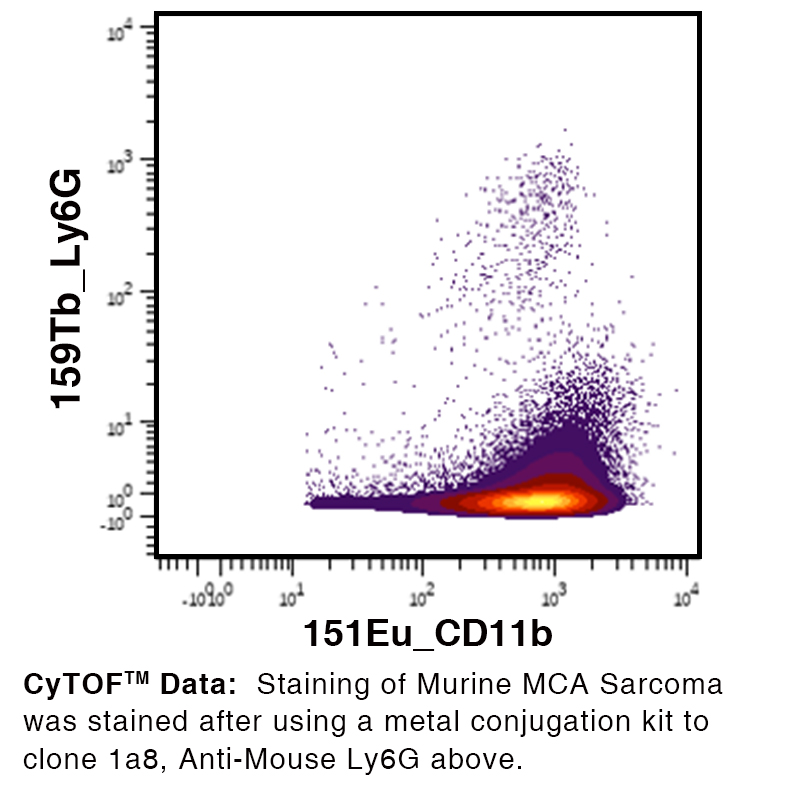Anti-Mouse Ly-6G – Purified in vivo PLATINUM™ Functional Grade
Anti-Mouse Ly-6G – Purified in vivo PLATINUM™ Functional Grade
Product No.: L305
[product_table name="All Top" skus="L305"]
- -
- -
Clone 1A8 Target Ly-6G Formats AvailableView All Product Type Monoclonal Antibody Alternate Names Lymphocyte Antigen 6 Complex Isotype Rat IgG2a Applications CyTOF® , Depletion , FC , IHC FF , in vivo , PhenoCycler® , WB |
- -
- -
Select Product Size | Qty Max: Min: 1 Step: 1 Select A Size |
Data
- -
- -
Antibody DetailsProduct DetailsReactive Species Mouse Host Species Rat Recommended Isotype Controls Recommended Dilution Buffer Immunogen Ly-6G transfected EL-4J cell line. Product Concentration ≥ 5.0 mg/ml Endotoxin Level <0.5 EU/mg as determined by the LAL method Purity ≥98% monomer by analytical SEC ⋅ >95% by SDS Page Formulation This monoclonal antibody is aseptically packaged and formulated in 0.01 M phosphate buffered saline (150 mM NaCl) PBS pH 7.2 - 7.4 with no carrier protein, potassium, calcium or preservatives added. Due to inherent biochemical properties of antibodies, certain products may be prone to precipitation over time. Precipitation may be removed by aseptic centrifugation and/or filtration. Product Preparation Functional grade preclinical antibodies are manufactured in an animal free facility using in vitro cell culture techniques and are purified by a multi-step process including the use of protein A or G to assure extremely low levels of endotoxins, leachable protein A or aggregates. Pathogen Testing To protect mouse colonies from infection by pathogens and to assure that experimental preclinical data is not affected by such pathogens, all of Leinco’s Purified Functional PLATINUM™ antibodies are tested and guaranteed to be negative for all pathogens in the IDEXX IMPACT I Mouse Profile. Storage and Handling Functional grade preclinical antibodies may be stored sterile as received at 2-8°C for up to one month. For longer term storage, aseptically aliquot in working volumes without diluting and store at ≤ -70°C. Avoid Repeated Freeze Thaw Cycles. Country of Origin USA Shipping Next Day 2-8°C RRIDAB_2893099 Applications and Recommended Usage? Quality Tested by Leinco FC The suggested concentration for this 1A8 antibody for staining cells in flow cytometry is ≤ 0.25 μg per 106 cells in a volume of 100 μl. Titration of the reagent is recommended for optimal performance for each application. Additional Applications Reported In Literature ? CyTOF® Depletion IHC FF WB Each investigator should determine their own optimal working dilution for specific applications. See directions on lot specific datasheets, as information may periodically change. DescriptionDescriptionSpecificity Clone 1A8 recognizes an epitope on mouse Ly6G. Clone 1A8 does not cross react with Ly6C. Background Ly6G antibody, clone 1A8, recognizes lymphocyte antigen 6 complex locus G6D (Ly6G; also called Gr-1), a 21-25 kDa glycosylphosphatidylinositol (GPI)-anchored protein1. Ly6G belongs to the lymphocyte antigen-6 (Ly6)/urokinase-type plasminogen activator receptor (uPAR) superfamily, characterized by a Ly6/uPAR (LU) domain-containing a three-fingered structural motif stabilized by disulfide bonds2. Ly6G is expressed by murine neutrophils regardless of location and activation1,4,5. Eosinophils may also express low levels of Ly6G5. There is no human ortholog for Ly6G; however, a structurally related L76/uPAR protein, CD177 (also known as HNA-2a, NB1, or PRV-1) is expressed in human neutrophils and is implicated in neutropenia6. Although the exact function and ligand of Ly6G remain unknown, Ly6G ligation may impair neutrophil migration to sites of inflammation via a β2-integrin-dependent mechanism7. Antigen Distribution Ly6G is expressed by neutrophils. PubMed NCBI Gene Bank ID UniProt.org Research Area Immunology . Innate Immunity References & Citations1. Fleming TJ, at al. (1993) J Immunol. 151(5):2399-408 2. Tsetlin VI. (2015) Trends Pharmacol Sci. 36(2):109-23 3. Daley JM, et al. (2008) J Leukoc Biol. 83(1):64-70 4. Lee PY, et al. (2013) J Leukoc Biol. 94(4):585-594 5. Percopo CM, et al. (2017) J Leukoc Biol. 101(1):321-328. 6. Stroncek DF. (2007) Curr Opin Hematol. 14(6):688-93 7. Wang JX, et al. (2012) Blood. 120(7):1489-1498 8. Tzetzo, S. L., Kramer, E. D., Mohammadpour, H., Kim, M., Rosario, S. R., Yu, H., Dolan, M., Oturkar, C. C., Morreale, B., Bogner, P. N., Stablewski, A., Benavides, F., Brackett, C. M., Ebos, J. M., Das, G. M., Opyrchal, M., Nemeth, M. J., Evans, S. S., & Abrams, S. I. (2024). Downregulation of IRF8 in alveolar macrophages by G-CSF promotes metastatic tumor progression. iScience, 109187. https://doi.org/10.1016/j.isci.2024.109187 Technical ProtocolsCertificate of Analysis |
Formats Available
- -
- -
Prod No. | Description |
|---|---|
L286 | |
L279 | |
L283 | |
L282 | |
L285 | |
L281 | |
L287 | |
L288 | |
L289 | |
L500 | |
L280 | |
L284 | |
L305 |



